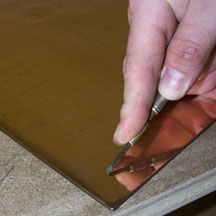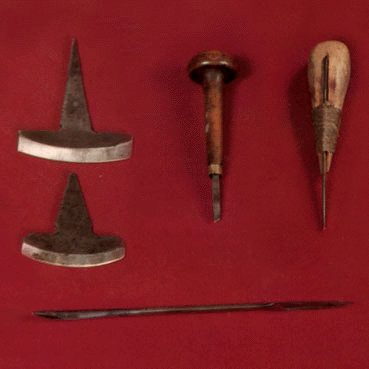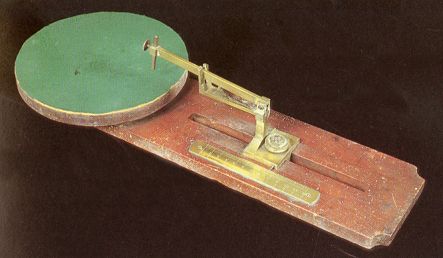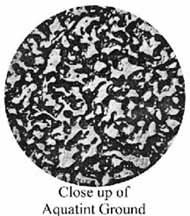
About Etchings & Engravings
In the world of printing and print making, almost all methods fall under one of 3 basic headings, Relief, Planographic and Intaglio. The latter method, "Intaglio", is the collective term for the the print making techniques that encompass engraving and etching.
The other forms of printmaking fall into two
basic groups. "Relief" (which includes letterpress
and woodblock printing) involves printing from a raised surface
(the opposite to Intaglio) and lacks the inherent ability to render
tones of varying strength (a raised surface cannot be "more
raised") the other is "Planographic" (including
various types of Lithography, as used in most commercial book &
magazine printing and for most other art prints) where the image
area sits on the same level as the non image areas, but has some
different property (usually water repellent as opposed to water
receptive.) Most methods in this group also lack the inherent
tonal capability of Intaglio. Its
distinction and the feature responsible for such "depth of tone" is that the
image on the plate is formed by lines and crevices cut below the surface rather
than by an image raised above the rest of the printing plate (as in relief) or
by different surface properties (as in
planographic)
ENGRAVING
Engraving as a printmaking
method was developed during the 15th Century when metal plates began to replace
the use of carved wooden printing blocks for the reproduction of works of art. A
plate of soft metal is used, most often copper, and the design engraved (cut
into) into the surface using a tool called a "burin" which is a square
tool-steel rod, sharpened diagonally at one end, such that the prominent corner
becomes an effective and controllable cutting edge.
 The highly skilled engraver uses the burin to cut an image, as a
series of lines of varying width and depth, that are a translation of the tones
and shadings of the artists original work. Deep lines hold more ink than shallow
ones, producing a darker tone when printed.
The highly skilled engraver uses the burin to cut an image, as a
series of lines of varying width and depth, that are a translation of the tones
and shadings of the artists original work. Deep lines hold more ink than shallow
ones, producing a darker tone when printed.
The degree of faithfulness
with which the engraving can represent the original image from a quite different
medium, such as an oil painting, is remarkable, and a testament to the engravers
own art.
The richness of inking in intaglio prints sets this method apart
from other printmaking techniques.
(Right) Using a burin to engrave a
copper plate
(Below right) engraving tools
 While copper is in many ways an ideal metal for engraving, it's softness which
enables it to be cut with reasonable freedom, is a disadvantage, when it comes
to printing from the finished plate.
While copper is in many ways an ideal metal for engraving, it's softness which
enables it to be cut with reasonable freedom, is a disadvantage, when it comes
to printing from the finished plate.
At this stage, the softness of the metal, means that the image is vulnerable to rapid wear from the wiping which is an integral part of intaglio printing. For this reason, during a period in the history of intaglio printmaking, many engravings were produced on steel rather than copper plates, which are much more durable by virtue of greater hardness of the metal. This hardness however, makes the task of the engraver very much more difficult, and restricts his style, by reducing his "freedom of expression".
The problem of rapid wear of copper engravings, together with the difficulty of engraving on steel, was solved in the late 1850's with the invention in France of the process of "steel facing". This revolutionary technique, a special form of the then new discovery of electro-plating, enables a very thin "skin" of steel (less than two ten-thousands of an inch) to be applied to an engraved or etched copper plate, imparting the hardness of steel to the engravers favourite metal of choice. Since it's invention, some one hundred and forty years ago, most engraved plates have been made on copper, and steel faced for protection from wear. Steel facing is used to this day, and is an essential part of preserving valuable copper plates, while still enabling them to be printed for all to enjoy.

Above
- a nineteenth century instrument which assisted in engraving accurate
circular lines onto copper or steel plates. The plate would be rotated on
the turntable whilst pressing the sharp pointed tip attached to
the tensioned arm onto the plate.
ETCHING
This method shares
many similarities with engraving, in so far as the aim is to produce crevices
and lines below the surface of a metal plate (also usually copper)
The
key difference from engraving, is the use of acid to actually remove the metal,
rather than to cut into the surface with a tool. The most basic form of etching,
commences with a layer of wax (known in etching as a "ground"), which is
resistant to the acids used, being applied to the cleaned surface of a flat
metal plate. The desired image is then drawn through the wax using a pointed
metal tool called an "etchers needle" so that the surface of the metal is
exposed through gaps in the wax. Once the drawing is complete, acid is applied
to the surface and it "bites" into the plate guided by the lines drawn through
the wax, producing lines and crevices that correspond to the image drawn. By
repeated masking of selected areas of the image, using a painted-on lacquer or
varnish, followed by re-applying the acid, lines of different depth, and hence
tone can be created to build up the final result.
 Because the etcher has only to draw the design through wax, rather
than wield a tool with sufficient force to cut into metal, it is possible for
the work to "flow" much more easily than with engraving. The easy strokes of the
needle, and the softness of line resulting from the work of acid, go together to
produce an appearance and tone in the finished print that bears resemblance to a
fine pencil drawing. This technique just described, called hard ground etching,
is perhaps the most elementary form of etching. Over the years however, a number
of other ways of using acid to etch a plate have developed.
Because the etcher has only to draw the design through wax, rather
than wield a tool with sufficient force to cut into metal, it is possible for
the work to "flow" much more easily than with engraving. The easy strokes of the
needle, and the softness of line resulting from the work of acid, go together to
produce an appearance and tone in the finished print that bears resemblance to a
fine pencil drawing. This technique just described, called hard ground etching,
is perhaps the most elementary form of etching. Over the years however, a number
of other ways of using acid to etch a plate have developed.
Shown (right) An enlarged illustration of an aquatint ground . .
.
Other etching techniques include aquatint (which produces a speckled tone
sometimes said to resemble water-colour washes), soft ground etching,
(photo)gravure etching (not to be confused with relief photoetch) and sugar-lift
etching. Very often, intaglio plates are made using a number of techniques
combined together to produce the effect that is desired. Sometimes engraving
methods may be used to finish a design and add additional detail in combination
with etching techniques to create the basic image.
Printing from the
finished plate, uses the same methods, whether the plate has been made by
etching or by engraving.
G.E. (Gravure etching, or Photogravure)
Gravure etching was probably the final revolution in intaglio publishing. Discovered by Nicephore Niepce in 1827, research into the method was continued by Fox-Talbot in the 1850s from where the subject did not really progress until it was finally developed commercially in the 1880s.
The process involves the use of a light sensitive gelatin which is applied to the copper plate. A positive image of the design to be etched is then placed in contact with the gelatin and then exposed. The special properties the gelatin ensure that where much light is received (the light areas of the design), the gelatin hardens, and remains softer in areas where less light is received.
The gelatin is then washed with water and the softer parts are dissolved away. The plate with the hardened gelatin is then placed in an acid bath and the acid gradually eats away at the gelatin surface and consequently the plate. Those areas of the gelatin that remained soft from exposure are relatively unresistant to the acid and so allow the plate to be etched fairly soon into the etching process; these are the darker areas of the plate which will consequently hold more ink. The areas of gelatin which received much light will remain hard throughout the etching and will only let acid onto the plate towards the end, or perhaps not at all; in these areas ink will not be held in any great quantity, if at all, and therefore will be very light or white in the corresponding impression.
The gravure etching process is extremely difficult, more of a craft skill than the art of an engraver, demanding in the etcher a unique knowledge and feel for the length of time that the plate must remain in the acid bath: too long and the plate will produce prints with too much contrast, too short and the prints will have a grey appearance. Often it can take several attempts and wasted plates before a satisfactory result is achieved. Various highlights will be added by selective wiping of the acid across the plate and by further work on the plate with a burnisher or burin.
A very detailed description of the process of photogravure can be found here at the website for The Kamakura Print Collection.
|
||||||
|
|
||||||
Home | Cart | Search | Browse | About the prints | Etching | Printing | Paper | Colouring | Artist biographies | Full examples | Ordering | Discounts | Shipping | Guarantee | Testimonials | Thomas Ross website | Links | Contact | Privacy |
© 2003-2025 Website copyright Steve Bartrick, Images Copyright Thomas Ross Limited
Unauthorised reproduction is prohibited
Steve Bartrick Antique Prints and Maps